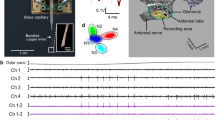Summary
Each aesthetasc hair of the lateral antennule of the California spiny lobsterPanulirus interruptus (Randall) is shown by light and scanning electron microscopy to be innervated by a basally situated cluster of sensory neurons encased in a glial sheath which isolates each cluster from those of other hairs (Figs. 1, 3, 4). The dendrites of these neurons penetrate the aesthetasc hairs and their axons extend to the central nervous system. Extracellular recordings with suction electrodes from the axons of single neuronal clusters were used to determine the responsiveness of individual hairs to a spectrum of amino acids, amines, amides, carbohydrates, carboxylic acids, nucleotides, and a tripeptide (Tables 1, 2, Figs. 6, 8). Randomly selected hairs from the antennules of juvenile, and male and female adult lobsters were shown to be broadly sensitive to a variety of stimuli and are homogeneous in their breadth of responsiveness (Figs. 5, 7). Cluster analysis does not reveal distinct chemoreceptive hair types based on their response spectra, suggesting that the receptor populations of single hairs are uniformly competent to respond to diverse chemical stimuli (Figs. 6, 8). Further, the sensitivity profile of aesthetascs to these stimuli correlates well with behavioral responses ofPanulirus interruptus to these same stimuli (Tables 1, 2).
Similar content being viewed by others
Abbreviations
- χ 2 :
-
Chi-squared
References
Ache BW (1982) Chemoreception and thermoreception. In: Atwood HL, Sandeman DC (eds) The biology of Crustacea, vol 3. Academic Press, New York, pp 369–398
Ache BW, MacMillan DL (1980) Neurobiology. In: Cobb JS, Phillips BF (eds) Biology and management oflobsters, vol 2. Academic Press, New York pp 165–213
Ache BW, Johnson BR, Clark E (1978) Chemical attractions of the Florida spiny lobsterPanulirus argus. Florida Sea Grant Technical Paper No. 10
Altner H (1977) Insect sensillum specificity and structure: an approach to a new typology. In: LeMagnen J, MacLeod P (eds) Olfaction and taste VI. Information Retrieval, London, pp 295–303
Altner H, Prillinger L (1977) Ultrastructure of invertebrate chemo-, thermo-, and hygroreceptors and its functional significance. Int Rev Cytol 67:69–139
Altner H, Sass H, Altner I (1977) Relationship between structure and function of antennal chemo-, hygro-, and thermoreceptive sensilla inPeriplaneta americana. Cell Tissue Res 176:389–405
Anderson PAV, Ache BW (1985) Voltage- and current-clamp recordings of the receptor potential in olfactory receptor cells in situ. Brain Res 338:273–280
Boeckh J (1981) Chemoreceptors: their structure and function. In: Laverack MS, Cosens DJ (eds) Sense organs. Blackie, London, pp 86–99
Derby CD, Ache BW (1984) Quality coding of a complex odorant in an invertebrate. J Neurophysiol 51:906–924
Derby CD, Atema J (1982) The function of chemo- and mechanoreceptors in lobster (Homarus americanus) feeding behaviour. J Exp Biol 98:317–327
Derby CD, Carr WES, Ache BW (1984a) Purinergic olfactory cells of crustaceans: response characteristics and similarities to internal purinergic cells of vertebrates. J Comp Physiol A 155:341–349
Derby CD, Hamilton KA, Ache BW (1984b) Processing of olfactory information at three neuronal levels in the spiny lobster. Brain Res 300:311–319
Devine DV, Atema J (1982) Function of chemoreceptor organs in spatial orientation of the lobster,Homarus americanus: differences and overlap. Biol Bull 163:144–153
Engelman L (1981) Cluster analysis by cases. In: Dixon WJ (ed) BMDP Statistical software. University of California Press, Berkeley, pp 456–463
Everitt B (1974) Cluster analysis. John Wiley & Sons, New York
Fuzessery ZM, Carr WES, Ache BW (1978) Antennular chemosensitivity in the spiny lobster,Panulirus argus: studies of taurine sensitive receptors. Biol Bull 154:226–240
Gleeson RA (1982) Morphological and behavioral identification of the sensory structures mediating pheromone reception in the blue crab,Callinectes sapidus. Biol Bull 163:162–171
Hansen K (1978) Insect chemoreception. In: Hazelbauer GL (ed) Receptors and recognition. Chapman and Hall, London, Ser B, vol 5, pp 223–291
Heimann P (1984) Fine structure and molting of aesthetasc sense organs on the antennules of the isopod,Asellus aquaticus (Crustacea). Cell Tissue Res 235:117–128
Johnson BR, Atema J (1983) Narrow-spectrum chemoreceptor cells in the antennules of the American lobster,Homarus americanus. Neurosci Lett 41:145–150
Kaissling KE (1971) Insect olfaction. In: Beidler LM (ed) Olfaction (Handbook of sensory physiology, vol IV/1). Springer, Berlin Heidelberg New York pp 351–431
Molen JN van der, Meulen JW van der, Kramer JJ de, Pasveer FJ (1978) Computerized classification of taste cell responses. J Comp Physiol 128:1–11
Mulloney B, Selverston AI (1974) Organization of the stomatogastric ganglion of the spiny lobster. I. Neurons driving the lateral teeth. J Comp Physiol 91:1–31
O'Connell RJ, Grant AJ, Mayer MS, Mankin RW (1983) Morphological correlates of differences in pheromone sensitivity in insect sensilla. Science 220:1408–1410
Price RB, Ache BW (1977) Peripheral modification of chemosensory information in the spiny lobster. Comp Biochem Physiol 57A:249–253
Reeder PB, Ache BW (1980) Chemotaxis in the Florida spiny lobster,Panulirus argus. Anim Behav 28:831–839
Sass H (1978) Olfactory receptors on the antenna ofPeriplaneta: response constellations that encode food odors. J Comp Physiol 128:227–233
Schaller D (1978) Antennual sensory system ofPeriplaneta americana L.: distribution and frequency of morphologic types of sensilla and their sex-specific changes during postembryonic development. Cell Tissue Res 191:121–139
Schaller L (1982) Structural and functional classification of antennal sensilla of the cockroach,Leucophaea maderae. Cell Tissue Res 225:129–142
Schneider D (1964) Insect antennae. Annu Rev Entomol 9:103–122
Selzer R (1984) On the specificities of antennal olfactory receptor cells ofPeriplaneta americana. Chem Senses 8:375–395
Smith DV, Travers JB (1979) A metric for the breadth of tuning of gustatory neurons. Chem Senses Flavor 4:215–229
Spencer M, Case JF (1984) Exogenous ecdysteroids elicit lowthreshold sensory responses in spiny lobsters. J Exp Zool 229:163–166
Spencer M, Linberg KA (submitted) Ultrastructure of aesthetasc innervation and external morphology of the lateral antennule setae of the spiny lobsterPanulirus interruptus (Randall)
Zimmer-Faust RK, Tyre JE, Michel WC, Case JF (1984) Chemical mediation of appetitive feeding in a marine decapod crustacean; the importance of suppression and synergism. Biol Bull 167:339–353
Author information
Authors and Affiliations
Rights and permissions
About this article
Cite this article
Spencer, M. The innervation and chemical sensitivity of single aesthetasc hairs. J. Comp. Physiol. 158, 59–68 (1986). https://doi.org/10.1007/BF00614520
Accepted:
Issue Date:
DOI: https://doi.org/10.1007/BF00614520




